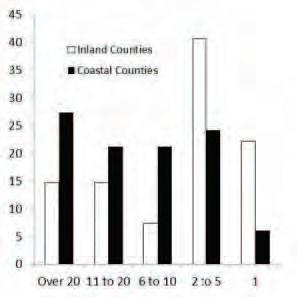OPIntegrating
planning for urban development with conservation of nature is one of the major challenges facing landuse planners today.

OPIntegrating
planning for urban development with conservation of nature is one of the major challenges facing landuse planners today.
By: Pam Pannozzo, Ph.D. and Reed Noss, Ph.D.
ver the next 25 years, in response to rapid human population growth, the amount of developed land in the United States is projected to increase by 79% - more than 44 million acres - primarily for housing. Unbridled urban development increasingly disassociates natural lands from their ecological functions, such as fire, and fragments existing conservation lands. With no national land-use or conservation policy in the United States, growth management is governed by state and local governments. States, however, vary widely in their growth management regulatory frameworks. Only a quarter of U.S. states have growth management laws that require local governments to protect nature through local land-use planning. Therefore, most landuse decisions affecting development and biodiversity protection are local and fall in the hands of local planning departments. A concern of conservationists is that uncoordinated local land-use decisions results
in a collection of activities that negatively impact and degrade the broader ecological landscape.
The state of Florida was a national leader in conservation planning from the 1970s until recently because of its ambitious state conservation lands acquisitions program and relatively strict growth management laws. Nevertheless, studies suggest that even where state law requires local governments to plan for environmental protection, local conservation planning tends to be highly variable in quality and implementation.
Researchers from the Science and Planning in Conservation Ecology (SPICE) Lab at the University of Central Florida conducted a survey of Florida county planning departments to assess the status of local conservation planning and its variability across counties. The study found that in most cases conservation planning focused on protecting tracts of land and employed species lists, habitat maps,
continued on next page
Table 1: Rank of awareness of planners and frequency of use of different types of biological information in land-use planning from highest to lowest.
* 7 = very aware, always used, 6 = very aware, sometimes used, 5 = somewhat aware, sometimes used, 4 = somewhat aware, rarely used, 3 = very aware, never used, 2 = somewhat aware, never used, 1 = not aware, never used
and vegetation surveys--deemed a pattern-based approach—but rarely used objective targets or performance measures for protection of communities and populations of species, a finding similar to other studies. Population viability models and information on genetics were rarely used in county conservation planning (Table 1 above).
While planners indicated they regularly used Geographic Information Systems for incorporating biological information in land-use planning, other conservation planning tools, such as human population growth models and data, land-use change models, and climate change and sea level rise projections were not often employed. Planners indicated they were unfamiliar with conservation science-specific tools such as threat modeling software, reserveselection algorithms, and conservation planning software (Table 2 below).
These findings were similar to those of other studies that conservation of nature is a common consideration in county-level land-use planning, but the top priority of planners is protecting “open space” (which includes agricultural land and sports fields, not just natural areas) from sprawl. Conservation of nature was ranked as a fourth priority by planners, after preservation of open space and quality of life, creation of neighborhoods and communities, and managing the cost of extending urban services. Planning for the impacts of climate change and sea level rise on native species and habitats were also considered low priorities.
continued from previous page continued on page 18
Table 2: Rank of awareness of planners and frequency of use of different resources for incorporating biological information in land-use planning from highest to lowest.
9 Conservation planning software (e.g. Fragstats, FunConn, Link)
* 7 = very aware, always used, 6 = very aware, sometimes used, 5 = somewhat aware, sometimes used, 4 = somewhat aware, rarely used, 3 = very aware, never used, 2 = somewhat aware, never used, 1 = not aware, never used
continued from previous page

Figure 1. Percentage of responses characterizing the size of the planning staff for Inland (n=27) and Coastal (n=33) counties in Florida.
Results of this study also showed there are significant differences between Inland and Coastal counties in the resources that are available to and employed by planners for conservation planning. Coastal county planning departments have more resources—financial, educational, infrastructure, staff—as well as greater knowledge of the types and sources of biological information, and resources for incorporating biological information into land-use plans, than Inland counties (Fig. 1). Coastal counties also engage in more collaboration with other governmental jurisdictions on conservation planning issues than Inland counties. These results generally mirror those of other studies showing that variability in the quality of land-use planning is linked to socioeconomic and political factors. These results of this study show opportunities exist to better integrate land-use planning and conservation science via informational resources to ensure that the best available tools for conserving native species and communities are being used to bridge the gap between research and practice. There is also opportunity for more exchange between local planners and decision-makers and conservation scientists as to how biological data can help inform and guide land-use planning decisions.
The complete survey results can be viewed at http://www.floridaplanning.org/wp-content/uploads/2014/06/ FCCPS_Survey_Results_and_Discussion_Final.pdf.
Dr. Pam Pannozzo and Dr. Reed Noss are with the Science and Planning in Conservation Ecology Lab at the University of Central Florida. Dr. Pannozzo can be reached at pannozzop@knights.ucf.edu.